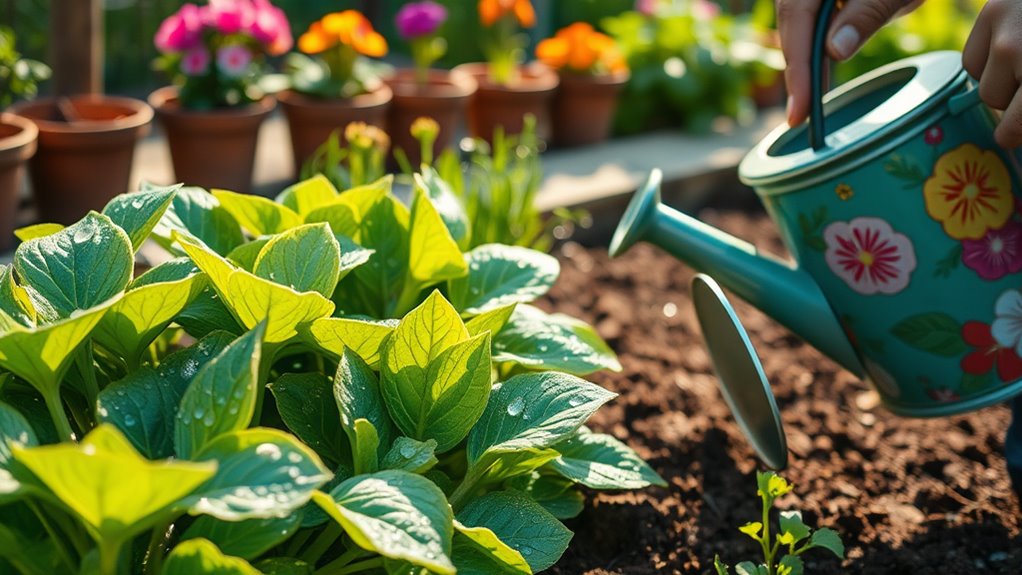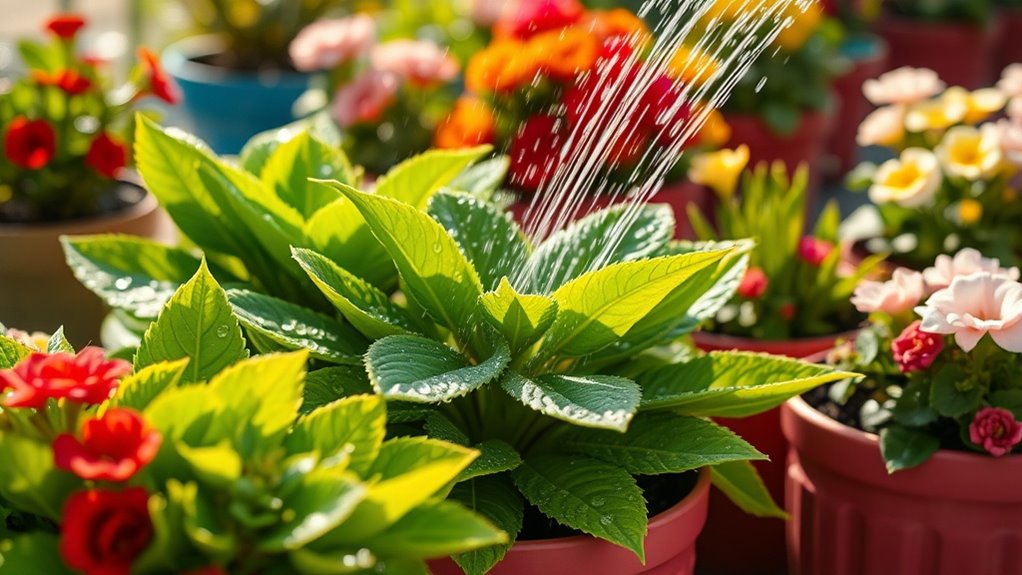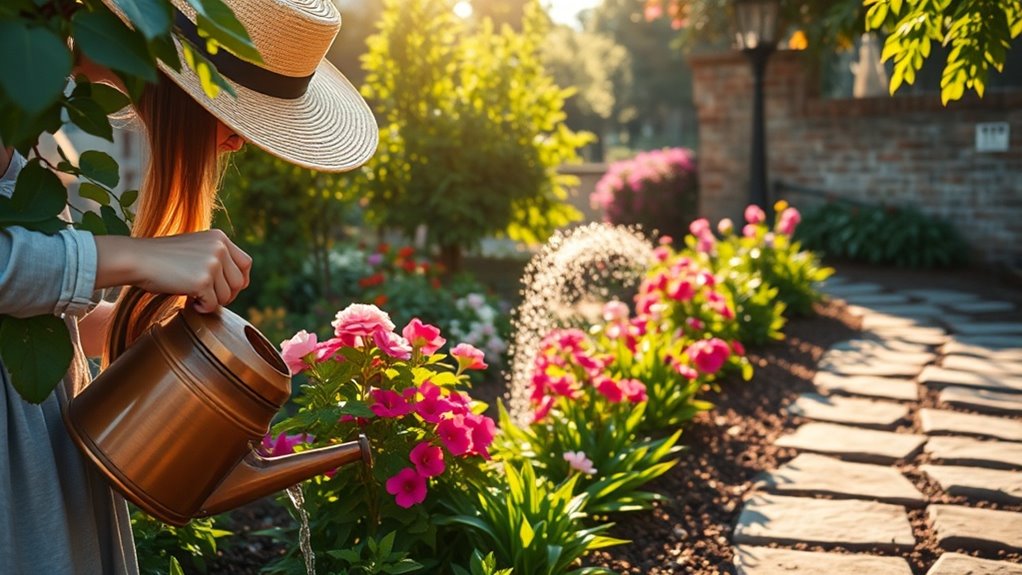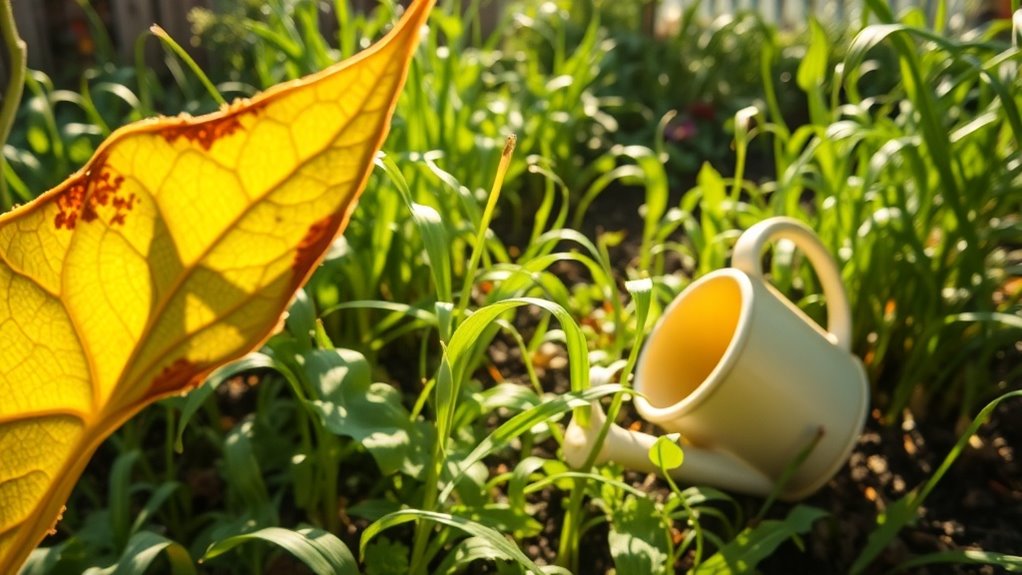Simple Daily Habits That Keep Your Garden Flourishing
You might not realize how simple daily habits can transform your garden into a thriving oasis. By incorporating mindful practices like morning walks to observe plant health and efficient watering techniques, you can create a vibrant environment for your plants. Regular weeding, composting, and strategic pruning not only enhance beauty but also promote growth. Curious about how these small actions can lead to substantial results? Let’s explore the essential habits that make all the difference.
Key Takeaways
- Start each day with a garden walk to identify pests, diseases, and other issues early.
- Water your plants in the morning to reduce evaporation and minimize disease risk.
- Regularly weed your garden to prevent competition for nutrients, water, and sunlight.
- Monitor plant health daily for signs of distress, like yellowing leaves or wilting.
- Apply natural fertilizers, like compost, to support ongoing nutrient enrichment for your plants.
Watering Wisely
How can you ensure your plants thrive while conserving water? By adopting easy garden habits, you can make a significant difference.
Start watering early in the morning or late in the evening when temperatures are cooler, reducing evaporation. Use a soaker hose or drip irrigation system to deliver moisture directly to the roots, ensuring efficiency.
Mulching around your plants retains soil moisture and keeps roots cool.
Additionally, group plants with similar water needs together to streamline your watering routine. Implementing a consistent watering schedule can further enhance plant health and growth.
With these simple yet effective techniques, you’ll nurture your garden while being mindful of water conservation, creating a lush, sustainable oasis.
Regular Weeding
Regularly weeding your garden can make all the difference in maintaining a healthy and vibrant landscape. Those pesky weeds compete for nutrients, water, and sunlight, stunting your plants’ growth.
Set aside a few minutes each day to pull them out, focusing on their roots to prevent regrowth. Use a hand trowel for deeper weeds, and consider mulching to suppress future growth. Additionally, implementing natural methods to eliminate garden weeds can enhance the effectiveness of your weeding routine.
Your efforts will pay off as your flowers and vegetables thrive without competition. Plus, the satisfaction of seeing a tidy garden will inspire you to nurture it even more. Dive in—your garden deserves it!
Observing Plant Health
To keep your garden thriving, you need to be vigilant about observing plant health. Look for subtle signs of distress like yellowing leaves or stunted growth, as these can signal underlying issues. Additionally, signs of overwatering can also manifest as wilting or droopy leaves, which may seem counterintuitive.
Signs of Distress
Have you noticed your plants looking a bit off lately?
It’s crucial to identify signs of distress early.
Pay attention to these indicators:
- Yellowing Leaves: This often signals nutrient deficiencies or overwatering.
- Wilting: Droopy leaves might mean your plants are thirsty or suffering from root rot.
- Brown Edges: Crispy leaf tips can indicate underwatering or high salt levels in the soil.
- Pests: Check for visible insects or webbing that can hinder your plants’ growth.
Regular Inspection Schedule
Consistently inspecting your garden can make a world of difference in maintaining plant health.
Set aside time each day to closely observe your plants.
Look for signs of pests, wilting leaves, or unusual discolorations. Notice the soil’s moisture level and check for weeds that compete for nutrients.
By catching issues early, you’ll prevent small problems from escalating into larger ones.
Use a notebook to track changes, noting which plants thrive and which struggle.
This routine not only enhances your garden’s vitality but also deepens your connection with nature, making every visit a rewarding experience for you and your plants.
Composting Daily
Composting daily transforms your kitchen scraps into nourishing gold for your garden.
By understanding the basics and knowing which materials to include, you can harness the incredible benefits of composting to enrich your soil and boost plant health. Additionally, employing smart methods can help you easily manage the composting process without unpleasant odors or mess.
It’s a rewarding practice that not only reduces waste but also connects you more deeply to the earth.
Composting Basics Explained
How can you transform kitchen scraps and yard waste into nutrient-rich soil? Composting is the answer!
By following a few simple steps, you can enrich your garden and reduce waste.
Here’s how to get started:
- Choose a compost bin: Pick a location and container that suits your space.
- Layer materials: Alternate between green (nitrogen-rich) and brown (carbon-rich) materials for balance.
- Turn it regularly: Aerate your compost every few weeks to speed up decomposition.
- Monitor moisture: Keep your compost damp, like a wrung-out sponge, for optimal breakdown.
With daily care, you’ll create a thriving ecosystem!
Ideal Materials to Use
Creating a successful compost pile hinges on the materials you choose to include.
Start with a mix of green materials like fruit scraps, coffee grounds, and grass clippings for nitrogen. Pair these with brown materials such as dried leaves, cardboard, and straw for carbon.
This balance fuels decomposition and enriches your compost. Avoid adding meat, dairy, and oily foods, as they attract pests.
Instead, think of your compost as a living ecosystem—each ingredient plays a vital role in nurturing your garden. By selecting the right materials, you’re not just composting; you’re creating a vibrant, organic foundation for your plants to thrive.
Composting Benefits for Gardens
Why should you embrace daily composting in your garden routine?
Daily composting transforms your kitchen scraps into a nutrient-rich treasure for your plants.
By incorporating this practice, you’ll enjoy several incredible benefits:
- Improved Soil Structure: Compost enhances aeration and water retention, creating a thriving environment for roots.
- Nutrient-Rich Fertilizer: Your compost provides essential nutrients, promoting vibrant plant growth.
- Waste Reduction: Composting limits landfill contributions, making your gardening eco-friendly.
- Pest and Disease Resistance: Healthy soil strengthens plants, helping them withstand pests and diseases.
Start composting daily, and watch your garden flourish!
Pruning and Deadheading
Pruning and deadheading are essential practices that breathe new life into your garden, enhancing both its beauty and health.
By regularly trimming back overgrown branches and removing spent blooms, you encourage fresh growth and vibrant flowers.
This simple habit not only keeps your plants looking tidy but also prevents diseases and pests from taking hold.
When you deadhead, you’re redirecting energy from fading flowers to new ones, ensuring a longer blooming season.
Grab your shears, and immerse yourself in the process; each snip invigorates your plants and deepens your connection to nature, creating a flourishing sanctuary right at your fingertips. Additionally, incorporating a simple routine for garden maintenance can further enhance the overall health and productivity of your plants.
Rotating Crops
As you plan your garden for the upcoming season, consider the powerful benefits of rotating crops.
This simple habit can rejuvenate your soil and boost your yields.
By changing your crops each year, you disrupt pest cycles and prevent soil nutrient depletion.
Here are four key advantages of crop rotation:
-
Improved Soil Health: Different plants require various nutrients, promoting balanced soil.
-
Pest Management: Disorient pests that thrive on specific crops.
-
Disease Prevention: Reduce the risk of soil-borne diseases.
-
Increased Biodiversity: Enhance the ecosystem, benefiting pollinators and beneficial insects.
Additionally, seasonal planting aligns with crop rotation, maximizing the benefits of your gardening efforts.
Embrace crop rotation for a thriving garden!





